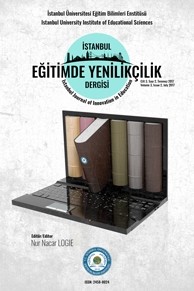Determine the Usage of Mobile Applications Among University Students
Determine the Usage of Mobile Applications Among University Students
Mobile applications, technology enhanced learning, Whatsapp Facebook, YouTube,
___
- Bennett, S., & Maton, K. (2010). Beyond the “digital natives” debate: towards a more nuanced understanding of students’ technology experiences. Journal of Computer Assisted Learning, 26(5), 321-331.
- Duffy, P. (2007). Engaging the YouTube Google-eyed generation: strategies for using Web 2.0 in teaching and learning. The Electronic Journal of e-Learning, 6(2), 119-130.
- Ebner, M., Lienhardt, C., Rohs, M. & Meyer, I. (2010). Microblogs in higher education: a chance to facilitate informal and process oriented learning? Computers & Education, 55, 92-100.
- Erkollar, A, & Onerer, B. (2011). Trends in social media application: the potential of Google+ for education shown in the example of Bachelor’s Degree course on Marketing. Communications in Computer and Information Sciences, 257, 569-578.
- Harris, M. (2011). Using YouTube to enhance student engagement. Retrieved February, 3, 2012 from http://www.ponce.inter.edu/html/retencion/using%20youtube.pdf
- Helsper, E. J., & Eynon, R. (2010). Digital natives: where is the evidence? British Educational Research Journal, 36(3), 503- 520.
- Johnson, K. (2011). The effect of Twitter posts on students’ perceptions of instructor credibility. Learning, Media and Technology, 36(1), 21-38.
- Jones, C., Ramanau, R., Cross, S., & Healing, G. (2010). Net generation or digital natives: is there distinct new generation entering university? Computers & Education, 54(3), 722-732.
- Junco, R., Elavsky, C. M. Heiberger, G. (2013). Putting Twitter to the test: assessing outcomes for student collaboration, engagement and success. British Journal of Educational Technology, 44(2), 273-287.
- Junco, R., Heiberger, G. & Loken, E. (2011). The effect of Twitter on college student engagement and grades. Journal of Computer Assisted Learning, 27(2), 119-132.
- Kennedy, G., Judd, T., Dalgarno, B., & Waycott, J. (2010). Beyond natives and immigrants: exploring types of net generation students. Journal of Computer Assisted Learning, 26(5), 332-343.
- Oblinger, D. (2003). Boomers, Gen-Xers and Millenials: Understanding the new students (pp. 37-47). Educause Review.
- Palfrey, J., & Gasser, U. (2010). Born Digital: Understanding the First Generation of Digital Natives. New York: Basic Books.
- Roodt, S., Joubert, P., De Villiers, C., & Oelofse, N. (2009). Collaborative learning in the Web 2.0 environment: an undergraduate case study. In Proceedings of the 1st International Conference on Education and New Learning Technologies (pp. 2249-2260). ISBN: 978-84-612-9801-3.
- Roodt, S., & De Villiers, C. (2011). Using YouTube as an innovative tool for collaborative learning at undergraduate level in Tertiary education. In Proceedings of the 4th International Conferences on Information Systems Management and Evaluation (pp.223-230). http://issuu.com/acpil/docs/www.academic-conferences.org
- Salomon, D. (2013). Moving on from Facebook using Instagram to connect with undergraduates and engage in teaching and learning. College & Research Libraries News, 74(8), 408-412.
- Sipahi, B., Yurtkoru, E. S., & Cinko, M. (2010). Sosyal Bilimlerde SPSS’le Veri Analizi. Istanbul: Beta Yayınları.
- Tapscott, D. (2009). Grown up digital. New York: McGraw-Hill.
- Wesch, M. (2011). The old revolution. Retrieved 24 April, 2014 from http://campustechnology.com/articles/2011/03/23/the-old-revolution.aspx
- ISSN: 2458-8024
- Başlangıç: 2015
- Yayıncı: İstanbul Üniversitesi
Student Oriented Bachelor Degree Engineering Studies
Romualdas KLIUKAS, Irina VINOGRADOVA, Dovilė ULINSKAITĖ, Vaidotas TRINKŪNAS
Observation of Young Age Individual’s Approach to a New Computer Fact
Assessment Approach with Mahara and Moodle in E-Learning
Özlem GÜZELYAZICI, Kemal GÜZELYAZICI, Kevser ŞAHİNBAŞ, Buket DÖNMEZ
Determine the Usage of Mobile Applications Among University Students
New Technology Experience in Turkey: The Case of Bitcoin
Şebnem ÖZDEMİR, Erkan LANPİR, Yeşim ATASOY, Sevinç GÜLSEÇEN
Cultural e-Learning Through Erasmus Experience Management
Bello MUAHAMMAD, Şebnem ZEREN, Sevinç GÜLSEÇEN
